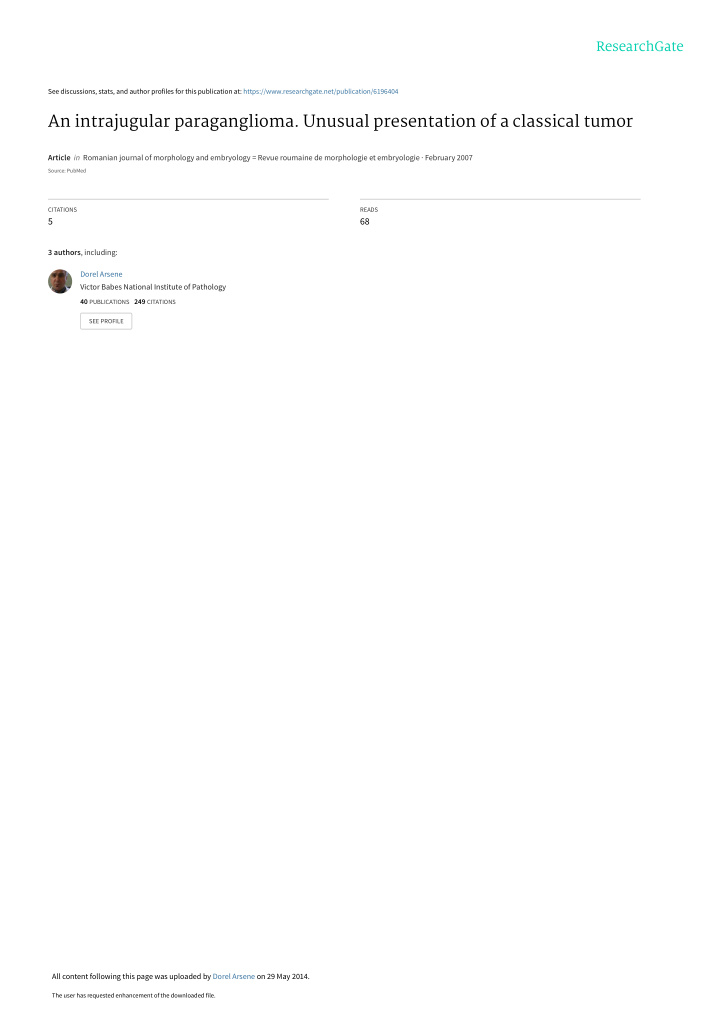



See discussions, stats, and author profiles for this publication at: https://www.researchgate.net/publication/6196404 An intrajugular paraganglioma. Unusual presentation of a classical tumor Article in Romanian journal of morphology and embryology = Revue roumaine de morphologie et embryologie · February 2007 Source: PubMed CITATIONS READS 5 68 3 authors , including: Dorel Arsene Victor Babes National Institute of Pathology 40 PUBLICATIONS 249 CITATIONS SEE PROFILE All content following this page was uploaded by Dorel Arsene on 29 May 2014. The user has requested enhancement of the downloaded file.
Romanian Journal of Morphology and Embryology 2007, 48(2):189–193 C A R E C R T AS SE E EP PO OR RT An intrajugular paraganglioma. Unusual presentation of a classical tumor D. A RSENE 1,2) , C ARMEN A RDELEANU 2) , L. D Ă N Ă IL Ă 3) 1) Department of Neuropathology and Anatomic Pathology, ”Vlad Voiculescu” Institute of Cerebrovascular Diseases, Bucharest 2) Department of Histopathology and Immunohistochemistry, “Victor Babe ş ” National Institute of Pathology, Bucharest 3) Department of Neurosurgery, “Vlad Voiculescu” Institute of Cerebrovascular Diseases, Bucharest Abstract Paragangliomas arise from the extraadrenal neuroendocrine system. They are locally aggressive tumors, causing adjacent invasion, bone destruction and compression related symptoms. We present a 35-years-old woman with a peculiar paraganglioma lacking all these features, and strictly located within the jugular vein. Differential diagnosis is detailed since other entities could have dissimilar clinical behavior. To the best of our knowledge, this is a very unusual site of occurrence for paragangliomas, and only two other comparable cases have been described. Keywords : paraganglioma, intrajugular, immunohistochemistry, prognosis, differential diagnosis. � I ntroduction The tumor was removed in block with the corresponding segment of the vein, with good Paragangliomas are tumors of the specialized postoperative evolution. extraadrenal neuroendocrine system. The overall The patient was discharged with no additional location of paragangliomas is in accordance to the sites therapeutic recommendations. of normal paraganglia: the carotid body, the Follow-up examinations up to one year later jugulotympanic body, the vagal body, etc. If the jugular disclosed only persistent facial hemiparesis and vein bulb is concerned, they are called glomus jugulare dysphonia. The MRI examination revealed no tumor tumours. The prevalence is low, paraganglioma recurrence. accounting for only 0.6% of neoplasms of the head and neck region [1]. Their classical evolution is toward local � Pathologic report invasion, with destruction of the petrous bone, following the low resistance paths, toward mastoid cell Macroscopically, the surgical material was a portion tracts [2], vascular channels [3], or Eustachian tube [4]. of the jugular vein, filled with a fleshy mass, the overall A strict intravascular localization within the jugular aspect being that of a sausage. vein is very rarely reported to date to our best Classic histological stains (Hematoxylin and Eosin, knowledge [5, 6]. In our experience, this is the first case Masson’s trichrome) were first performed. with such a particular presentation. Microscopically, the tumor appeared rigorously restricted to the vein lumen, with no invasion of any of � Clinical report the vessel wall structures or of small lymph node, which was also removed (Figure 2). The patient, a 35-years-old woman, was admitted to The tumor had the typical aspect of a our hospital with dysphonia, and left facial asymmetry paraganglioma, with cells arranged in nests or with a 12-months duration. In the last 3–4 days, clusters separated by a rich vascular stroma (Figure 3). appeared new symptoms: headache, gait troubles and No mitoses or necroses were detectable. nausea, as well as dysarthria, dysphagia and dysphonia. Immunohistochemistry was performed on the The physical examination revealed paresis signs of paraffin-embedded material using the EnVision+ most cranial nerves on the left side (VI, IX, X, XI, XII). Dual Link System Peroxidase kit (Dako, Carpinteria, A contrast CT-scan showed a tumor mass in the CA, USA), according to the manufacturer’s instructions. jugular vein superior bulb, with strong contrast Primary antibodies against the following antigens enhancement. The MRI revealed the same aspect, of a were used: chromogranin (1:100) (Novocastra, tumor of 38/35/45 mm with intermediate signal in Newcastle Upon Tyne, UK), synaptophysin (1:50), T1-weighted and hyper-signal in the T2-weighted S100 protein (1:500), Ki67 (1:100), CD34 (1:50), sequences, with strong enhancement after intravenous FVIII associated antigen (1:50), CD31 (1:40), administration of gadolinium (Figure 1). GFAP (1:50) (Dako, Glostrup, Denmark).
Recommend
More recommend